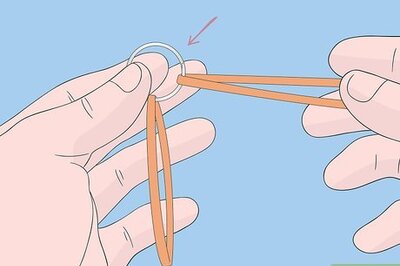
views
New Delhi: Pragyan Ojha and R Ashwin may or may not have known it, but when they took the field as India’s spinners for this Test – Ojha as leader, Ashwin on debut – they were entering a venue where India’s legacy of spin had a rich history.
The Feroz Shah Kotla has been a good ground for India, and more so for Indian spinners. In seven Tests at the Kotla, Anil Kumble took a staggering 58 wickets at 16.79, including his epic 10 for 79 against Pakistan in 1998-99; Harbhajan Singh and Bishan Bedi took 18 and 19 wickets respectively from four appearances here; BS Chandrasekhar 23 from five, with his career-best 8 for 39 taking place at the Kotla; Erapalli Prasanna 13 from two, including combining with Bedi to spin India to a famous win over Australia in 1969-70; S Venkataraghavan snared 19 wickets from six Tests here, and he chose the Kotla to produce his best figures in Tests – 8 for 72 against New Zealand in 1964-65, in his debut series.
This was India’s first Test at at home without either Kumble or Harbhajan since 2000. Ojha had not played a Test since last November, Ashwin was playing his first. The odds were stacked against the pair but they rose to the occasion, combining for 16 of the 20 West Indian wickets that fell inside three days. Of those 16, seven were lbw and three bowled. Granted this team doesn’t consist of great players of spin, but the chokehold displayed on the batsmen – Shivnarine Chanderpaul largely excepted – by Ojha and Ashwin was admirable.
In the first innings it was Ojha who starred with six, and in the second Ashwin did the same. The over that turned the match today was Ashwin’s 12th, the 30th of the innings and 16th of the day, a double-wicket maiden. No doubt watching how Darren Bravo was keen to get his pad forward, Ashwin lured the batsman forward with a straighter one that thudded into the front leg. It was the second time Ashwin had dismissed Bravo in the match, and it was smartly bowled from around the stumps – straight out of Harbhajan’s book.
Ashwin knew that there was little bounce in the surface – typically an offspinner’s greatest supporter – and so he slowed his pace, kept the ball full, and used the carrom ball sparingly. Unlike the finest exponent of the doosra, Saqlain Mushtaq, who used to toss them up on off stump and lure the batsman into a drive, Ashwin uses the carrom ball as a means of getting wickets bowled and lbw, much like Muttiah Muralitharan. In limited-overs cricket he bowls this delivery frequently, but he had hardly done so in this match. Perhaps Marlon Samuels’ time away from international cricket has limited his opportunities of facing such deliveries, for he did not see what was coming. The carrom ball drew him forward, went away, and hit off stump.
The big wicket came soon after lunch, and it was one Ashwin should be proud of. Ashwin had mostly operated around the stumps of Chanderpaul, but soon after he changed tactics he had his man. Pitching an offbreak from over the stumps, Ashwin got minimal turn and that did for Chanderpaul who pushed at it with bat and pad together.
With Chanderpaul in ominous touch all match, Ashwin had to bide his time but he did not lose sight of what he needed to do each time he went back to his mark. There were some deft touches from Chanderpaul, supple of wrists, but Ashwin didn’t lose focus. Perhaps he knew that he could produce, as he did, the goods in quick succession. After that double-wicket maiden, he was given another spell and took three for 26 to give himself match figures of 9 for 128, the second best for an Indian on debut following Narendra Hirwani’s 16 for 136 against West Indies in 1988.
Ashwin’s craft is not lethal. It is a handy, aggressive brand of offspin honed from playing a lot of limited-overs cricket. Tall and gawky, though not scrawny, his action is not the prettiest; a mix of whirling arms and a bit of a fast bowler’s hold just as he delivers the ball. But his height ensures that he can extract bounce on most surfaces. In addition, Ashwin has developed a carrom ball and possesses enviable control. This, allied with an enthusiastic attitude, makes for a smart bowler. You sense, watching Ashwin barge in, that he wants and expects a wicket every ball.
Ojha, in the unfamiliar role of lead spinner after a lengthy stint out of the team, was coming off a six-wicket haul in the first innings. He picked up a wicket in the final over of the second day, and though he wasn’t successful today he had done more than enough to stamp his authority on this Test. Clearly the chance to play County cricket has helped, and the manner in which Ojha plugged away on a slow and low wicket – which he termed “unhelpful” – was impressive.
By leading India’s depleted and inexperienced bowling attack in a Test that demanded something special after the tour of England, Ojha and Ashwin put India on course for victory. Admittedly, West Indies are not the best players of spin and the pitch was helpful as well, but Ojha and Ashwin were at the batsmen all the time. Their control and perseverance, facets they have both displayed in the shorter formats, were there for all to see. They bowled well, and that cannot be disputed.
It was perhaps fitting that the two combined at the Kotla, venue of several famous spin-induced wins for India. The pair is no Kumble or Harbhajan – who took 356 wickets playing alongside each other in 34 Tests at home – but they turned in match-winning performances befitting of India’s two most successful spinners. While they are far from inheriting that legacy of spin, the two have enhanced their reputations significantly.



















Comments
0 comment